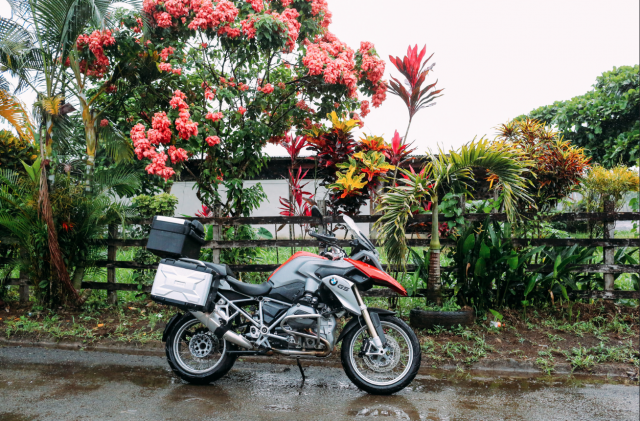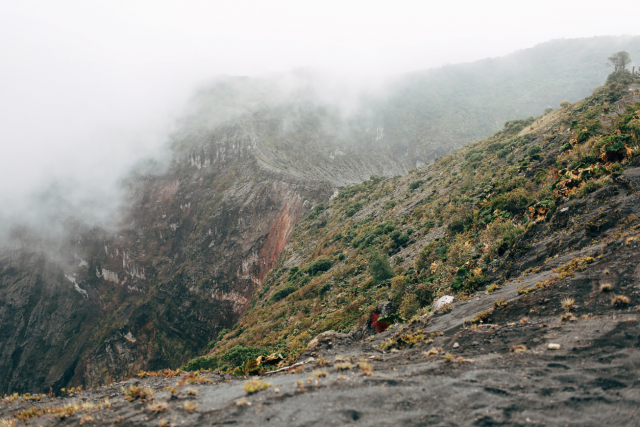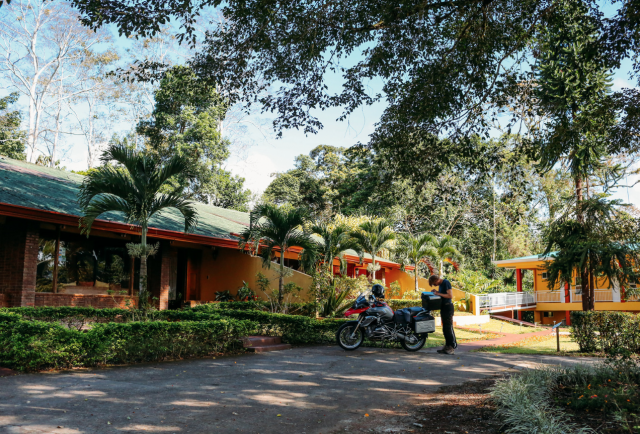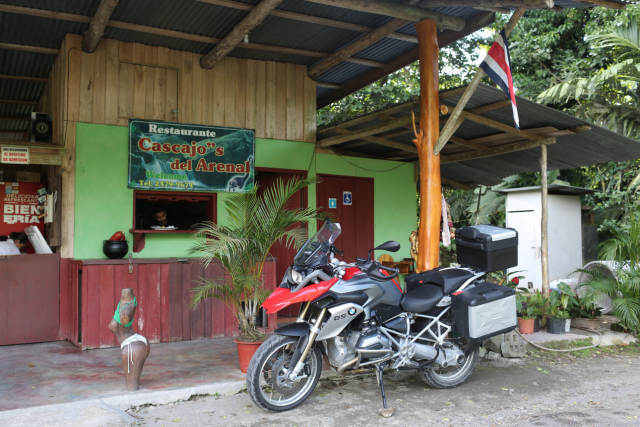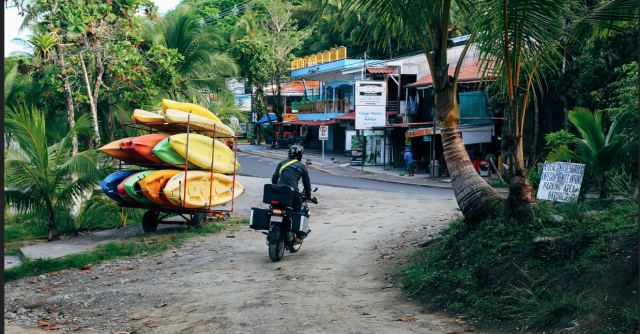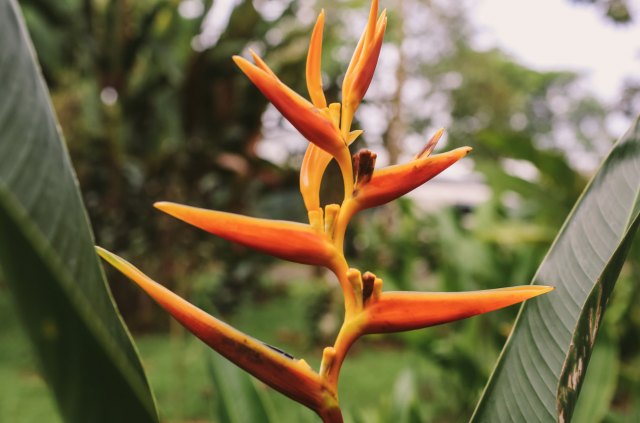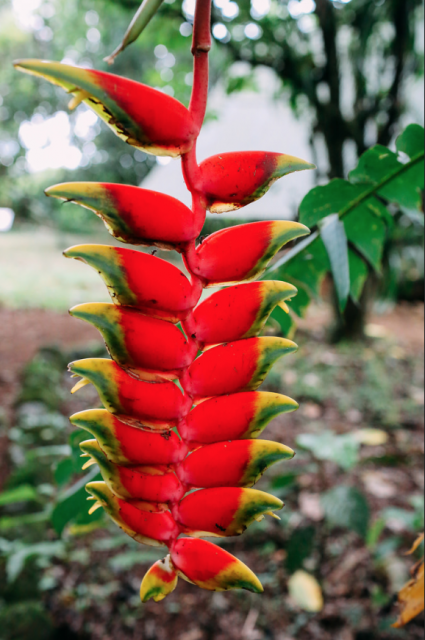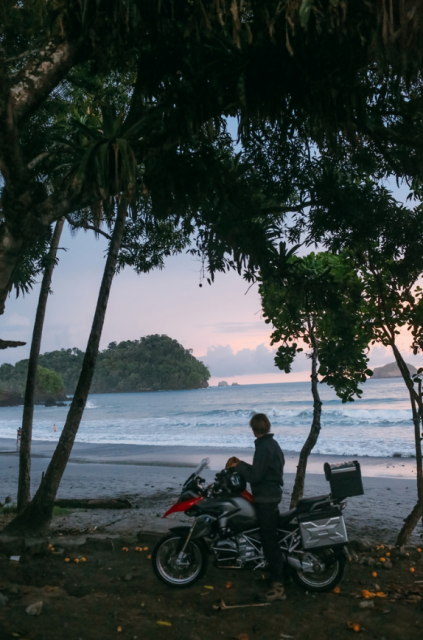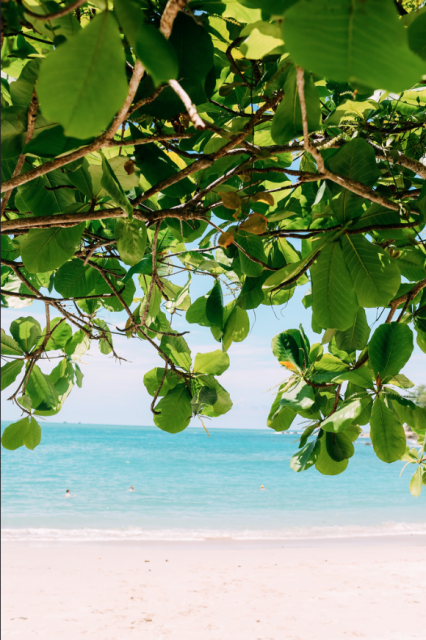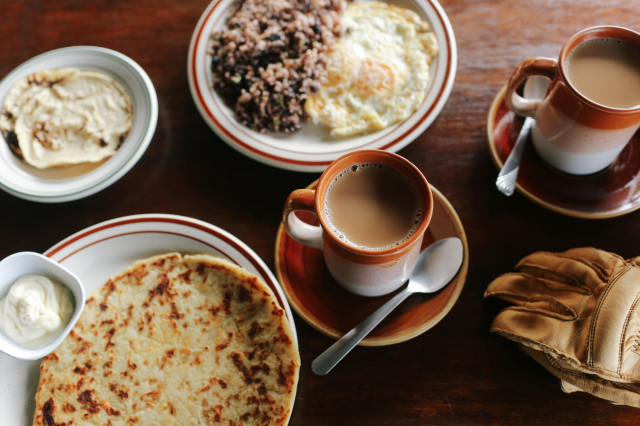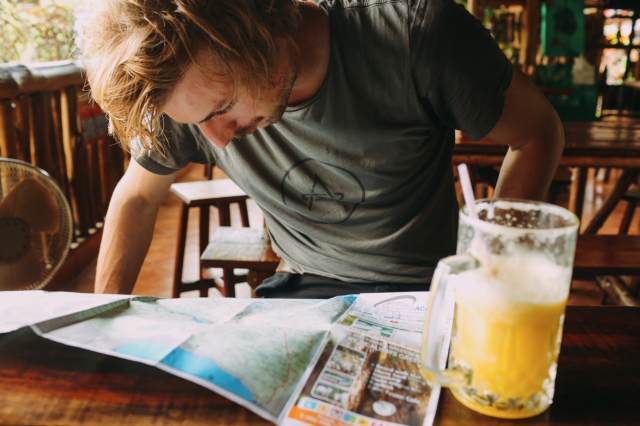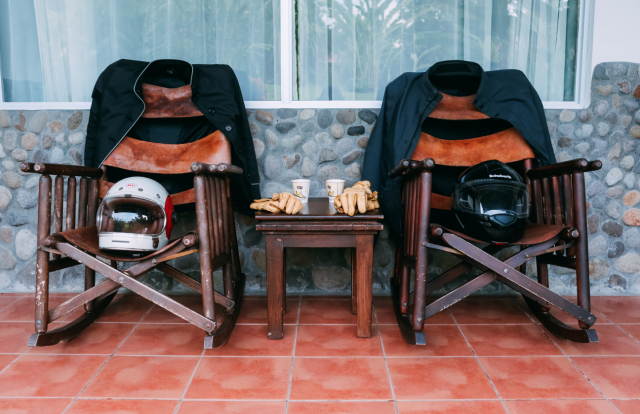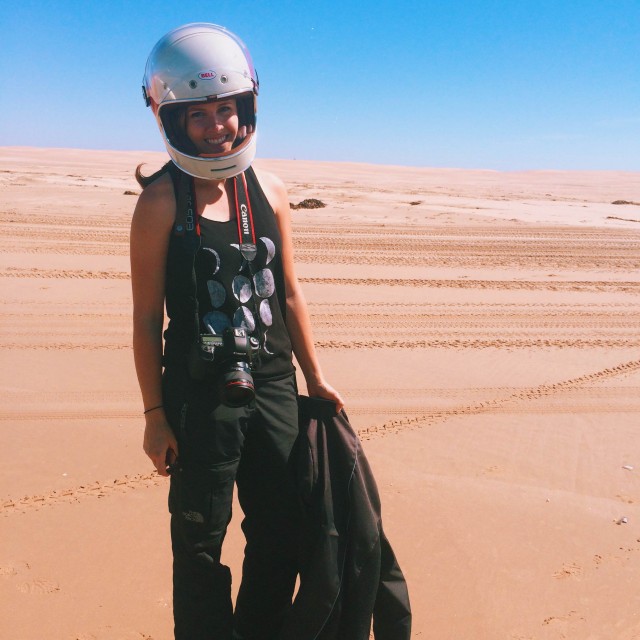We were cruising down the Pan-American Highway on a new water-cooled BMW 1200GS, as the tropical vegetation whizzed by in an ever-changing kaleidoscope of green. Although we were traveling at a decent clip, it wasn’t fast enough to outrun the oppressive midday heat. Things will cool down once we make it to the coast, I remember thinking. Just then, I caught a glimpse of something red and blue in my side mirror and suddenly, alongside me in the opposing lane, roared a police pickup truck, inexplicably and frantically honking its horn. Ignoring the road in front of him, the driver was wildly gesticulating at me through the tinted window to pull over. “Well, shit”, I said, as I pointed the bike towards the dirt shoulder ahead, “This should be interesting.”
Megan and I arrived in San Jose six days ago. After months of careful planning, our long-awaited trip to Costa Rica was finally underway. The plan was to spend nine days exploring the country by motorcycle, riding two-up, and carrying all our own luggage with us as we went. The bike rental and hotels had been booked ahead of time through the travel company Costa Rican Trails, but we would be in charge of getting ourselves from one place to another. While it was far from a self-supported expedition, it wasn’t exactly an all-inclusive tour either. Instead the trip fell into that pseudo-risky yet not-entirely safe gray zone commonly referred to as Adventure Tourism – something for which Costa Rica has become world-renowned.
We arrived in San Jose at dawn, red-eyed and jet-worn, but the city’s vibrant energy – along with a few cups of strong coffee – revived us. The streets were bustling with taxis jockeying for position while a steady stream of foot traffic poured down the main pedestrian boulevards. Close to our hotel, the local city park was being so fully utilized that it looked like the overly optimistic renderings of some fresh-faced city planner. It had slack lining, a skate park, stilt walking, foosball tables, a drum circle, poetry reading, parkour lessons, silk aerial acrobatics, and rows of people playing chess. It felt as if there were an energy pulsing through the warm tropical air and the people here had found a way of tapping into it. Later that night we went out for a drink and by chance caught the championship game of Costa Rica’s national soccer league, an event that ended in a citywide celebration after the hometown team pulled out a win. As we staggered back to the hotel at the end of the first day, we concurred that if the rest of the trip was this action-packed it might just kill us.
The next morning we went to pick up the bike from the BMW Motorrad dealership of San Jose. It was unclear when I made the reservation what version of the 1200GS we’d be getting, so naturally I assumed it was going to be some old beat-to-hell rental. My only hope was that it wasn’t one of those mid-2000 models with the annoying servo-assisted brakes. But much to our surprise, we found a brand new water-cooled 1200GS sitting out front, all polished and waiting for us. After we did a basic rundown on the bike and pushed and prodded our gear into the less-than-spacious Vario cases, the representative from Costa Rica Trails scrawled out our route for the next week in meticulous and occasionally legible detail on a paper map. With this precious piece of paper as our guide, we signed on the dotted line and rode off the lot with a $17,000 motorcycle onto unfamiliar streets, in a foreign country, the language of which neither of us could speak fluently. The smell of adventure was in the air.
A few general notes about the roads in Costa Rica. A few years back, the government made a nation-wide push to repave, or, more correctly, pave for the first time, many of the major roads that run throughout the country. While streets in the cities were pretty dismal, the main connecting routes were in absolutely pristine condition. However, despite all the careful planning that went into building these roads, it seemed that the signage needed to label them had been tragically forgotten. In fact, it was virtually impossible to figure out where you were using the names of streets, because even if the street did have a name, nobody else seemed to know it. When we had to ask for directions– which was pretty frequent– the response invariably came in the form of distance plus some context clue, such as: go 8 kilometers, then turn right by the billboard, then go another 5 kilometers and turn left by the restaurant with the Coca Cola sign. However, if the advertisement on the billboard had changed or if all the restaurants we passed had Coca Cola signs, we’d be forced to inquire again and receive an entirely new set of directions. And so in this way, we bumbled forwards towards our destination with precision of a game of Marco Polo. All these observations, and many more, were made in the short time it took us to travel from San Jose to our first stop: the volcano of Irazu.
Sharply rising off the valley floor and twisting up a magnificent mountain road, we snaked our way through terraced pastures and hillside hamlets. For us, coming from drought-stricken Southern California, the sight of these lush verdure fields was as refreshing as a tall glass of water on a hot summer’s day. As we continued to climb, the greenery started to give way to dark volcanic rocks and we ascended into a thick wall of fog. Speed was reduced and brakes were covered, but we cautiously pressed on. As we rose higher, the fog grew brighter and brighter until finally we could make out small patches of blue in the churning sea of clouds.
At the summit we dismounted and walked along the volcano’s edge. There, swirly waves of white crashed down upon the hard black sands, like rolling waves at a beach. While beautiful and serene, the place had an eerie, almost otherworldly quality to it. Were it not for the occasional fern or bush, it could have easily been mistaken for the barren surface of a far distant planet. We took in all the limited visibility would allow before heading back down into the valley below.
Later that day, we rode up a long dirt road to our hotel outside Turiabla. The first to greet us was a colony of Oropendolas – large blackbirds with brilliant yellow tails – who were nesting high above in the branches of a massive fig tree. Absolutely incredible to listen to, these enthusiastic birds sounded something like R2D2 playing the kazoo and left little doubt we were well within in the tropics.
Shortly after checking in at the Villa Florencia, we began to realize just how seriously Costa Rica takes the whole “eco-tourism” thing. Solar-powered LEDs orbs lit the path to our room, which was set up with a self-regulating sink, low-flow toilet, low-volume showerhead, and electricity that only worked when your keycard was inserted. Even the elusive WiFi signal felt like it was being rationed. Naturally, as an American, my initial reaction was to feel oppressed by such environmental concerns, to which I defiantly exclaimed “I’m on vacation, damn it! I’ll save the planet later!” But thankfully, with Megan’s help, I was able to come to my senses and appreciate their earnest efforts towards conservation. In the US, we place almost all of our focus on the “recycle” part of the equation – so not to damper our relentless rate of consumption – but in Costa Rica they seem to be making a real go at trying to “reduce” their waste in the first place. To do this requires occasional moments of personal awareness and self-restraint, which, we’re happy to report, left us no worse for the wear.
As we continued through the lowlands during the next couple days, it became clear we were passing through motorcycle country. Out here, nearly every house had a bike parked in front of it and other riders were a constant sight out on the road. For the most part they were all riding small cc Japanese imports: Yamaha YBR 125s, Suzuki DR200s, Kawasaki KLR 250s, or for those who wanted to consider themselves real cowboys, 250cc Honda Rebels. But what these little bikes lacked in horsepower, they made up for in sheer numbers.
With the locals so well versed in motorcycle culture, we found that our comparatively massive 1200GS would create quite a stir whenever we pulled into town. At one roadside restaurant, known collectively throughout the country as “Sodas”, the entire kitchen staff piled out to get their picture taken with the bike as I attempted to field questions the best I could. Far from the glassy-eyed indifference or even faint contempt with which the majority of the non-riding public display towards motorcycles in America, everyone we met in Costa Rica seemed to be genuinely excited about them, which, in turn, was really exciting for us.
Midway through our trip we arrived at the town of La Fortuna, located at the base of the famous, and still quite active, Arenal Volcano. Here the country’s resplendent adventure tourism industry was on full display. All around town were brilliantly colored billboards advertising zip lining, white water rafting, canyoneering, kayaking, horseback riding, and ATVing, while fleets of air-conditioned vans shuttled wide-eyed, fanny-packing tourists from one action packed activity to the next. It was as if the taste of adventure – in all its tropical flavors – was being served buffet-style to anyone with a wallet deep enough to afford it.
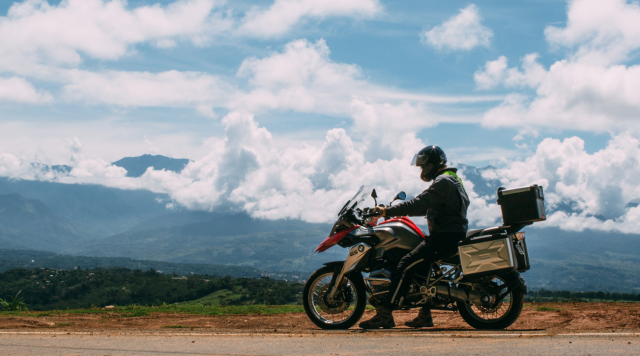
Upon seeing the telltale signs of a well-oiled tourist town, our initial contrarian impulse was to go off and do our own thing. We wanted to be a part of something real, not some slickly marketed, mass-produced Costa Rican “experience.” Wasn’t that the whole point of touring the country by motorcycle anyways, to get away from the fake commercialized façade? But then another thought came to us: Was it really possible to visit Costa Rica and not go zip lining? Had all these iconic activities become so synonymous with the place itself that they were now inseparable?
Some clarity was brought to the question when it was revealed to us that nearly all the country’s tour companies are owned and operated by Costa Rican citizens, thanks to protective government regulation. This meant that instead of having the whole tourist business foist upon them by some foreign corporation, the people of Costa Rica were both the facilitators and the beneficiaries of the recent influx of tourism dollars. This put an entirely new spin on things. Perhaps the burgeoning adventure tourism industry is, in fact, the most authentic thing happening in Costa Rica right now, for it’s occurring naturally of its own accord. Furthermore, as outsiders, who were we to insist the people here maintain an agrarian existence indefinitely just to satisfy our romanticized expectation of pastoral country life? If the people of Costa Rica have chosen adventure tourism as their path to deliverance, then who were we to oppose them? And so at last, with our delicate moral compasses aligned and our hypersensitive consciences cleared, we went zip lining – and, as one might expect, it was awesome.
Dawn comes early in the tropics. Costa Rica doesn’t observe daylight savings, which meant that the sun rose around 5am in the morning and set just before 6pm at night. If one was to avoid the heat of the day, it was imperative to get out on the road as early as possible. Megan isn’t normally much of a morning person, which meant that “vacation Megan” was even less inclined to the notion, yet somehow we were able to shift our schedules to wake before sunup. On the day we were to depart from La Fortuna we managed to drag ourselves out of bed in time for a dawn patrol run along Arenal Lake, an endeavor that was well-rewarded. On most days, a thick layer of clouds hides the volcano’s peak, to the point where even the locals say they only get to see the top a few times a year. Either we were there on the right day or the fun-loving, late-partying locals of La Fortuna aren’t morning people either, but we caught a few fleeting glimpses of the bare summit in the early golden morning rays. However, by the time we turned the bike around, the head of the mountain king was already adorned with a puffy crown of white.
We were cruising down the Pan-American Highway as the tropical vegetation whizzed by. It was getting late in the day and the air was starting to get hot. We were settling in for a long haul down to our final destination: the Pacific beach town of Quepos, when suddenly I heard the frantic and sporadic horn and saw a police pickup truck come racing up along side me. At first I thought he was just trying to pass, but the menacing stares and commanding hand gestures made it all too clear that we were the ones he was after. A part of me sensed something was not quite right about the situation, but going full-throttle on a rental bike in a foreign country just didn’t seem like a reasonable alternative, so I decided to pull over.
I put the bike over on the dirt shoulder and Megan and I dismounted. The pickup truck pulled up alongside us. After a momentary and dramatic pause, the door opened and out heaved a rotund man with a gruff, determined look across his face. He looked vaguely annoyed, and inexplicably out of breath, as if he had been chasing us on foot. I had no idea what he wanted, but nothing about his facial expression boded well for us. In fact, the way I saw it, we had only one chance of this ending well. So it was with great trepidation I played my one and only card. “¿Habla Ingles?” I said, with an expression outwardly hopeful yet quietly desperate. His face contorted into a scowl of vexed agitation before curtly responding with “No, Señor.”
That’s it, I thought, we’re screwed. He’s going to confiscate the bike, take our travel documents, and send us to rot in some local gulag until our next of kin pay for our ransom. I was cursing myself for getting Megan mixed up in this whole thing, when the cop said sternly “Necesitan ropa mas reflectiva” as he motioned at our jackets. It took a moment before I realized what he was talking about, but then finally it clicked. Thankfully we were in Costa Rica, not Mexico, and he was only telling us we needed to be wearing reflective clothing.
We were told at the beginning of the trip that it was required by law in Costa Rica to wear reflective gear at all times. I was wearing a Skyline jacket by Aether Apparel and Megan was wearing a Café Mesh jacket by GoGo Gear. Both jackets have matte reflective piping built-in to their seams, but in the sunlight these features are designed to disappear. The intended result is a stylish-looking jacket during the day, but one that is also highly reflective when you need it – at night. However, the explanation of technical fabrics and their reflective properties was not something we spent much time on in high school Spanish. And so, in butchered Spanish along with highly animated hand motions, I began to make my case to the officer that we were, in fact, wearing reflective gear, even though under the blinding noonday sun it didn’t appear that we were. He gazed on in quiet, contemplative bemusement.
Finally, after a frantic, disjointed, and undoubtedly incoherent appeal to the officer’s sympathy, which at one point had me showing him a blurry picture of the jacket at night on my iPhone, I was able to somehow talk us out of getting a ticket. While I’d very much like to think he was moved by the soundness of my arguments, in reality, I suspect he just got worn down by my unrelenting blathering and wanted to get on with his day. We were free to go, but on the condition that we purchase some more reflective gear as soon as possible. This we immediately took care of at a nearby Honda dealership, where we bought bright yellow reflective sashes, which we donned for the rest of the trip like gilded hall monitors.
It was a long, hot grind down to Quepos. In the broiling heat of the afternoon, we blitzed through mile after mile of palm plantations containing countless rows of perfectly spaced trees. We were hot, we were uncomfortable, and we both wanted to be done with the bike for the day, yet the rows of palms kept coming at us like the endless looping background of a video game. At last, we pulled into the tiny coastal town of Quepos, where upon I immediately got lost looking for our hotel. Despite feeling like we had both hit a wall, another thirty minutes was required in order to discern the seemingly contradicting scribbles in the margin of our provided map. These were tense, desperate moments. Finally, we arrived at the Costa Verde hotel. We checked in, stripped down, and collapsed face-first into the closest pool we could find.
The cool water revived us and we were able to appreciate our surroundings with fresh eyes. Our hotel, along with many others, was perched high upon the cliffs that overlooked the Pacific Ocean. Small bungalows were tucked away on terraced levels, but the most noteworthy room was a converted 727-passenger plane that the resort had retrofitted into a master suite. Its orange emblazoned fuselage jutted out from the green jungle undergrowth like a beacon calling out to aviation buffs and retro-kitsch admirers alike.
That afternoon we sat on the back porch of our bungalow watching distant towering thunderclouds parade their way down the coast. Golden light from the setting sun cast down upon their dark, billowy contours and reflected off the shimmering surface of the water to create a scene both heroic and serene, like some seascape oil painting by a 17th century Dutch master. As trying as the day’s travel had been, we both felt this majestic display was just compensation for such a hard long day on the bike.
The next morning we set out to investigate the nearby Manuel Antonio National Park, which is set apart from the mainland and connected only by a narrow isthmus. Here we found an impressive collection of wildlife: sloths, squirrel monkeys, howler monkeys, toucans, scarlet macaws, iguanas, and a particularly rambunctious raccoon-like creature known as a coati. We attempted a short hike around the peninsula, but quickly found that the steamy tropical heat, terrarium-like humidity, and hilly coastal terrain made even the most leisurely pace felt like an arduous death slog. We therefore abandoned our hopes of hiking in exchange for extended time at that beach, where we set about practicing our floating in the warm Pacific waters.
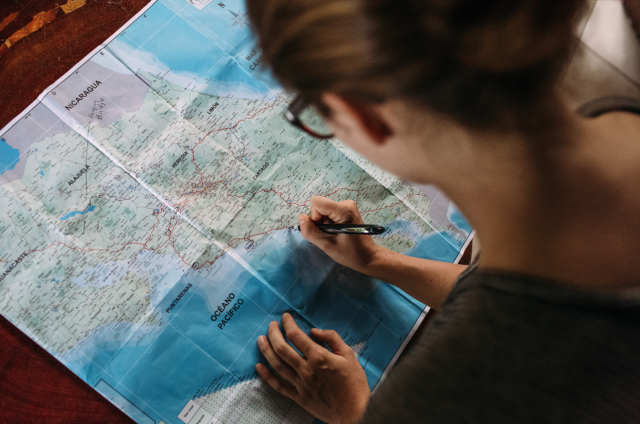
The next day it was time to depart Quepos and make our way back to San Jose. The instructions from the tour company advised us to retrace our steps along the coast, however a careful examination of the map revealed that there was an alternate route further inland, which passed through the mountains. Still smarting from the grueling haul down the coast and looking for any possible way to get out of the heat, we inquired at the front desk about the feasibility of this route. When asked, the jovial manager behind the counter turned grave and began to express his concerns.
He said it was very cold up in the mountain, with little visibility due to constant cloud coverage, and a lot of oil spills from trucks. The road also passes over one of the highest points in Costa Rica, known throughout the country as “Cerro de la Muerte” or Mountain of Death. With each new hazard he listed it became clear, maybe not to Megan, but certainly to me, that we had to go that way; there was no other choice. Like the foreboding warning given to the main character at the beginning of the movie, it was now a matter of dramatic destiny that we ride out and face whatever it was we were explicitly told to avoid. There was no other way.
The temperature started to cool as we ascended from the coast and began to make our way into the foothills of the mountains. We fuelled up at San Isidro del General, the last major town of note, and likely the last gas station we would see before we got to the outskirts of San Jose. On the way out of town we passed by a giant statue of Jesus, who, from his hillside perch, looked down over the road with outstretched arms, perhaps in loving embrace, or perhaps to flag us down and tell us to turn back. However, we passed him by all the same.
The road began to climb dramatically, twisting and turning through cliffs as it continued its relentless incline. Rolling waves of fog intermittently reduced our visibility, but as we continued to ascend, their frequency increased until we were fully enveloped in a dense, misty cloudbank. The temperature continued to drop too, so much so that we had to close the vents on our jackets and throw on another layer. I even went so far as to turn on the bike’s heated hand warmers, although this was more of a luxury than a necessity. Perhaps spending the last several days acclimating to the warm weather had thinned my blood more than I thought.
Along the side of the road we saw clusters of modest homes, small rural markets, and the occasional church. These highland communities, shrouded in thick fog for much of the year, were completely different from the rest of the sunny postcard Costa Rica we had seen. The people up here had a slower, simpler style of life due greatly to their relative isolation, but also a calm, unhurried repose that I chalked up to the more humane climate. This style of life was captured fully at one of the sleepy roadside Sodas, where we, and few other travelers, lazily sipped coffee on the back porch while watching banks of fog drift through the valley. It seemed very peaceful up there in the mountains and was one of the many places in the country I could envision myself living for a period of time.
While we didn’t come across any of the infamous oil spills, we did manage to find a backlog of traffic as we were approaching the Mountain of Death. There, an army of road workers had reduced us down to a single lane, which required traffic to be alternated through a single corral of cones. The line of idling cars and tractor-trailer trucks looked like a haunting apparition in the passing mist, calling to mind the type of mass exodus seen right before an impending zombie invasion. And so it was, in this rather undistinguished way, that we crawled over the Mountain of Death. Waiting in a line of traffic on the top of a mountain was not the type of final showdown I had envisioned when I set out on this route, but perhaps it was the nemesis I should have expected all along.
Our ears popped as we started to descend into the San Jose area, as warm air wafted up from the valley like heat from an open oven. The toll road that we rode into town on was the first multi-lane highway we had been on since the beginning of the trip, and it became apparent that we were exiting the countryside and entering the maze-like urban sprawl of the city. We were scheduled to drop the bike off at the BMW dealership that afternoon, but had got turned around more than once on the narrow one-way roads. As fortune would have it, we had arrived in the city during rush hour, which meant that even a single wrong turn required a grueling roundabout correction through near standstill traffic. At last, we were able to break free of the vortex-like suction of downtown and found out way to the drop point.
The 1200 GS had performed admirably throughout the trip, and I couldn’t imagine touring the country as we did on any other bike, however, at this particular moment in time, both Megan and I wanted nothing more than to get off it. It had been a long trip and we were very much looking forward to sitting on anything other than a motorcycle seat. Still, it was an amazing vehicle to ride and in many ways ideally suited to access all Costa Rica had to offer. From the twisty mountain roads, to the long slabs of straight highway, to the gravely dirt driveways, the 1200 GS proved again and again to be the perfect bike for the job. So it was not without a twinge of sadness that I popped the kickstand, leaned the bike over, and got off it for the last time.
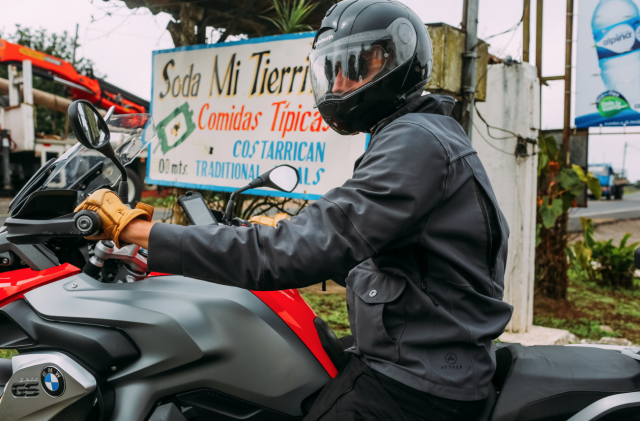
With the bike finally returned and our flight back to Los Angeles leaving at some ungodly hour the next morning, there was an overwhelming sense that our time in Costa Rica was coming to an end. However, despite our mental and physical exhaustion, we somehow managed to rally for one last drink out – which is to say we trundled down to the bar next to our hotel. In hindsight, the swinging saloon doors and classic rock karaoke should have given it away, but in our weary state of mind it wasn’t until we ordered that we realized we had stumbled straight into an American expat bar.
Upon seeing our fine northern-European complexion, we were immediately surrounded by a bunch of red-faced, grey-haired men, who were keen on extolling all the virtues of Costa Rica, the likes of which we had just seen. Originally, these folk had come from all over, but now were well-paid managers at call-centers, freelancing for large tech firms, or just living off their retirement package. They were in complete and utter rapture over Costa Rica’s great weather, gorgeous beaches, relatively modern infrastructure, laid back lifestyle, and affordable cost of living. “Why would anyone live in the states when they could be living the dream down here?” they asked, “Everyday is just another day in paradise.” And, basking in the after-glow of our trip, we found ourselves inclined to agree.
Yet, despite their boisterous attitude and cheery disposition, a faint sadness seemed to hang about their eyes. Like a thin coat of paint covering a piece of rusting metal, their glossy exterior barely hid the trouble beneath. It didn’t take us long to find out that all of these guys were alone, the result of a messy divorce, a career-ending layoff, or a life of chronic estrangement. They had visited Costa Rica on vacation at some point or another, and, remembering the good times they had, struck upon the idea to move down here permanently. Now they spend their nights in expat bars drinking, laughing, and telling their tale to anyone who will listen, trying to recapture that fleeting sensation of being on vacation. We finished our drinks, thanked the gentlemen for their acquaintance, and headed back to our room, feeling strangely out of sorts.
As we quietly rode the shuttle back to the airport the next morning, the thought of the expats lingered with me like the bittersweet moral at the end of a story. The trip had been tremendous success by all accounts, a near perfect vacation in my mind. Furthermore, as a country, Costa Rica had exceeded our every expectation. In such a diverse tropical haven, brimming with a youthful vigor and sanguine optimism about its future, it was hard not to be taken in completely. To tell the truth, there were many times I wished the trip would never end, that we could cancel our flight back home, quit our jobs, and just keep riding the roads down there forever – endlessly chasing the next immaculately-paved turn. Yet, in my heart of hearts, I knew it had to end. Unlike the expats, who were desperately trying to cling onto that feeling of excitement, of adventure, I knew, in back of my mind, that we had to let it go. For paradise is not a really place, but the road you take to get there.
Megan McDuffie:
Determined to combine her passion for visual expression with an outdoor lifestyle, she’s currently taking as many adventures as her day job will allow. Her latest project is the camp-food blog Fresh Off the Grid that features recipes designed specifically for cooking in the outdoors. freshoffthegrid.com



